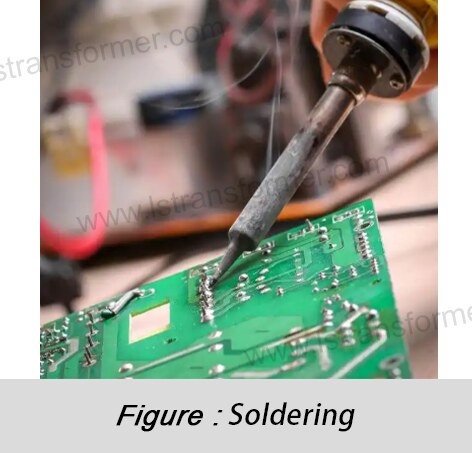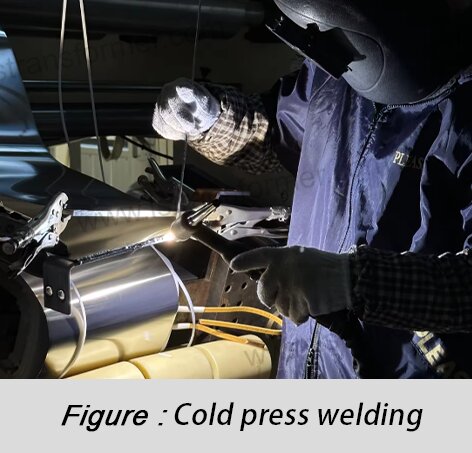Which is More Reliable: Laser Welding, Soldering, or Cold Crimping? —A Comparison of Winding Wire Joining Processes
Which is More Reliable: Laser Welding, Soldering, or Cold Crimping?
—A Comparison of Winding Wire Joining Processes
In the manufacturing of transformers and reactors, the choice of joining process directly impacts device efficiency, lifespan, and failure rates. Laser welding, soldering, and cold crimping exhibit significant differences in conductivity, mechanical strength, and thermal stability. Each method also carries potential failure risks that require careful evaluation. For example, the heat-affected zone (HAZ) in laser welding may cause uneven high-frequency current distribution, the low melting point of soldering can lead to secondary short circuits during overloads, and micro-voids in cold crimping may increase contact resistance over time. This article compares the core metrics and failure consequences of these processes, referencing international standards (IEC 60076, IEEE C57.12.00), to provide selection guidelines for high-reliability applications.
Content
1. Conductivity Comparison
● Laser Welding
The metallurgical bond in laser welding provides conductivity close to that of the base material. However, grain coarsening in the heat-affected zone (HAZ) can increase localized resistivity. In high-frequency transformers, this microscopic non-uniformity exacerbates the skin effect, causing localized overheating and accelerating insulation carbonization. For instance, a study (IEEE Transactions on Power Delivery) showed that resistance fluctuations in the HAZ can increase high-frequency losses by 5%-8%.
● Soldering
Soldering relies on alloy materials, which have an inherent resistivity about six times higher than copper. Worse yet, solder oxidation and thermal fatigue cracks can progressively increase contact resistance. In one case (EPRI report), a soldered joint in an oil-immersed transformer saw a 30% rise in contact resistance over three years due to solder creep at 120°C, ultimately leading to winding burnout.
● Cold Crimping
Cold crimping avoids thermal damage through mechanical compression, but micro-voids can generate micro-arcs under current flow, and oxidation may gradually increase contact resistance. NASA research found that unplated cold crimps in extreme space temperature cycles exhibited a 15%-20% resistance increase over a decade.
Process | Initial Resistivity | Primary Degradation Mechanism | Typical Consequences |
Laser Welding | ~1.68×10⁻⁸ Ω·m | HAZ grain coarsening | High-frequency hotspots, insulation aging |
Soldering | ~10⁻⁷ Ω·m | Oxidation/creep/thermal fatigue | Overheating, secondary short circuits |
Cold Crimping | ~2×10⁻⁸ Ω·m | Micro-void oxidation | Contact resistance drift, micro-arcs |
Table 1: Conductivity and Long-Term Risk Comparison
2. Mechanical Strength Comparison
● Laser Welding
While laser welds can achieve 90% of the base material’s strength, residual stress and HAZ embrittlement reduce fatigue life. A wind turbine transformer case (Wind Energy Journal) revealed fatigue cracks originating from the HAZ after eight years of vibration, leading to winding fracture.
● Soldering
Soldering offers the lowest mechanical strength (30-50 MPa), and thermal cycling stress can cause joint cracking. Automotive reactor data showed soldered joints failing after 2,000 temperature cycles (-40°C~125°C), whereas laser welds endured over 5,000 cycles.
● Cold Crimping
Cold crimp strength depends on compression rate, but over-crimping can sever wire fibers, weakening the joint. Industry statistics (ICEA S-97-682) indicate that 12% of field failures stem from insufficient compression due to die wear.
3. Thermal Stability Comparison
● Laser Welding
Laser welds share the base material’s melting point (copper: 1083°C), but rapid cooling may create brittle phases. A high-speed rail transformer failure analysis (EN 50329) attributed brittle fracture to excessive weld hardness under short-circuit forces.
● Soldering
Soldering’s critical flaw is its low melting point. In UL certification tests, lead-free solder (SAC305) softened at 217°C, causing inter-turn shorts during 150% overloads.
● Cold Crimping
While heat-resistant, stress relaxation reduces contact pressure over time. ASTM B542 tests showed an 18% crimp force decline in copper terminals after 1,000 hours at 150°C, necessitating elastic seals for compensation.
Process Selection Guidelines
Application Scenario | Recommended Process | Key Risk Mitigation Measures |
High-frequency/high-temperature (e.g., aerospace) | Laser Welding | Argon shielding to reduce oxidation, post-weld heat treatment |
Low-cost/low-frequency repairs | Soldering | High-silver solder (Sn96Ag4), mechanical reinforcement |
Mass-produced power transformers | Cold Crimping | Silver plating, regular die calibration |
In Summary
Laser welding, soldering, and cold crimping each have distinct advantages for winding wire joining. Laser welding excels in conductivity and mechanical strength, making it ideal for high-reliability applications like high-frequency or high-temperature environments, though HAZ control is critical. Soldering is cost-effective and easy to perform but is limited to low-frequency, low-power, or temporary repairs due to its low melting point and oxidation risks. Cold crimping offers the best balance of cost and stability for mass production, provided silver plating and die maintenance address micro-void and stress relaxation issues. Future advancements, such as IoT-based resistance monitoring and hybrid laser-assisted crimping, may further enhance reliability and adaptability in transformer manufacturing.
Contact Us
LuShan, est.1975, is a Chinese professional manufacturer specializing in power transformers and reactors for 50+ years. Leading products aresingle-phase transformer, three-phase isolation transformers,electrical transformer,distribution transformer, step down and step up transformer, low voltage transformer, high voltage transformer, control transformer, toroidal transformer, R-core transformer;DC inductors, AC reactors, filtering reactor, line and load reactor, chokes, filtering reactor, and intermediate,high-frequency products.
Our power transformers and reactors are widely used in 10 application areas: rapid transit, construction machinery, renewable energy, intelligent manufacturing, medical equipment, coal mine explosion prevention , excitation system, vacuum sintering(furnace), central air conditioning.
Know more about power transformer and reactor :www.lstransformer.com.
If you would like to obtain customized solutions for transformers or reactors, please contact us.
WhatsApp:+86 17267488565
Email:marketing@hnlsdz.com

 EN
EN
 FR
FR DE
DE ES
ES


